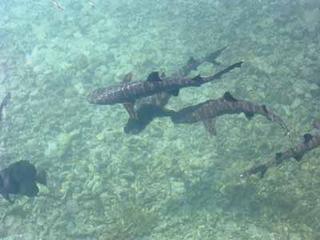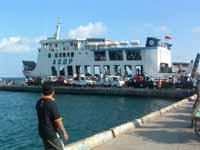Maritime expedition retraces RI-African link
Indonesians have for many centuries been renowned as daring seafarers, roaming the globe to faraway places.
To reconstruct its past glory, Indonesia has organized two major sea voyages using replicas of famous old phinisi ships in the past two decades.
The first expedition, called the Phinisi Nusantara, ended at the Vancouver World Expo in 1986. The second, aboard a phinisi ship called the Amanna Gappa, ended in disaster when it sank in the waters off Africa in November 1991 after leaving Madagascar.
Other, lesser expeditions, have used modern tall ships, such as the Navy training ships the Dewa Ruci and Arung Samudra.
Now organizers are making final preparations for another major expedition, with a ship built based on reliefs at the ancient Borobudur Temple in Central Java.
The Borobudur Ship Expedition, as it is called, will feature a 25-meter-long ship with rectangular sails and equipped with double outriggers.
Briton Philip Beale, a former member of the Royal Navy, saw the reliefs after conducting research on Tami trading canoes in Papua New Guinea. He wanted to reconstruct a ship based on the reliefs and use it travel to Madagascar.
As a researcher, Beale believes that Indonesian sailors played an important role in the so-called Cinnamon Route, which brought cinnamon from the Indonesian archipelago to East Africa and then Egypt and Europe.
"The Indonesians did it in the first millennium -- much, much earlier than the Vikings finding North America or the Spanish and Portuguese armadas," Beale told The Jakarta Post.
Beale will soon see the ship from the relief come to life. A group of shipbuilders launched the "Borobudur ship" on the last week of May near Pagerungan island off Bali.
The ship was built on Beale's initiative, and the shipbuilders used techniques that date back to the 8th century.
For example, they used coconut fibers instead of nails to bind parts. The ship was built under the guidance of a well-known Australian maritime adviser, Nick Burningham, and under the supervision of a seasoned traditional shipbuilder, Assad.
President Megawati Soekarnoputri is scheduled see off the expedition members in Jakarta on Aug. 15, when they leave for Madagascar, which they hope to reach in October. The next stop after that is Cape Town, and the voyage will then continue along the western coast of Africa to its final destination, Ghana, in December.
"This expedition should be good for Indonesia's profile and tourism in this difficult time, by sailing the boat from here to Africa like a cultural celebration," Beale said.
Trade between Indonesia and Madagascar started between the fourth and eight centuries, bringing the influence of Indonesia to Africa.
"The expedition should bring about the profile of Indonesia as a maritime nation and should help raise the profile of Indonesia, the skill and heritage of that time," Beale said.
He said the expedition and shipbuilding would cost up to œ200,000 (US$320,000), with most of the initial funding coming from the organizers, Tanya Alwi of Indonesia, Beale, Berningham and the state ministry of culture and tourism.
The expedition's executive director, Tanya Alwi, described the expedition as a "big project".
"The ship will be manned by a crew of 12 or 13, and six of them will be Indonesians while the rest will be an international crew.
"We have put out an advertisement seeking interested individuals to become crew members. The selection process will be handled by the Indonesian Navy," she said.
Tanya said a seasoned Indonesian Navy officer would serve as the ship's skipper.
The ship will be equipped with modern navigation equipment, such as GPS (global positioning system). A couple of small engines have been included to facilitate the ship's entrance and exit from ports.
"This is a sailing expedition and we want to reenact the ancient voyage, so we won't just turn the engine on and whizzz ..," Biele said.
While the boat is already afloat, the masts and outriggers will be added later this month.
"Then we will test the ship in June and sail it to Jakarta sometime in July. So we have about one month of testing," said Beale.
Tanya said the organizers would welcome interested anthropologists or marine biologists on board. Recruits from the Boy Scouts are also being sought.
The organizer of the expedition plans to hold a seminar on July 3 in Jakarta.
"It will cover such issues as how people built ships in the 8th century, the cultural relations between Indonesia and Madagascar, why, how and when we went there, how to have maritime character building, how we package cultural heritage for tourism.
"We also want to have the seminar in Madagascar, Cape Town and the Maldives. The idea is to highlight cultural and trade missions in the expedition," Tanya said.
Beale will donate the ship to Indonesia after the expedition, she said.
Additional information on the expedition can be found at www.borobudurshipexpedition.com.
Published on The Jakarta Post on Saturday, June 14, 2003
To reconstruct its past glory, Indonesia has organized two major sea voyages using replicas of famous old phinisi ships in the past two decades.
The first expedition, called the Phinisi Nusantara, ended at the Vancouver World Expo in 1986. The second, aboard a phinisi ship called the Amanna Gappa, ended in disaster when it sank in the waters off Africa in November 1991 after leaving Madagascar.
Other, lesser expeditions, have used modern tall ships, such as the Navy training ships the Dewa Ruci and Arung Samudra.
Now organizers are making final preparations for another major expedition, with a ship built based on reliefs at the ancient Borobudur Temple in Central Java.
The Borobudur Ship Expedition, as it is called, will feature a 25-meter-long ship with rectangular sails and equipped with double outriggers.
Briton Philip Beale, a former member of the Royal Navy, saw the reliefs after conducting research on Tami trading canoes in Papua New Guinea. He wanted to reconstruct a ship based on the reliefs and use it travel to Madagascar.
As a researcher, Beale believes that Indonesian sailors played an important role in the so-called Cinnamon Route, which brought cinnamon from the Indonesian archipelago to East Africa and then Egypt and Europe.
"The Indonesians did it in the first millennium -- much, much earlier than the Vikings finding North America or the Spanish and Portuguese armadas," Beale told The Jakarta Post.
Beale will soon see the ship from the relief come to life. A group of shipbuilders launched the "Borobudur ship" on the last week of May near Pagerungan island off Bali.
The ship was built on Beale's initiative, and the shipbuilders used techniques that date back to the 8th century.
For example, they used coconut fibers instead of nails to bind parts. The ship was built under the guidance of a well-known Australian maritime adviser, Nick Burningham, and under the supervision of a seasoned traditional shipbuilder, Assad.
President Megawati Soekarnoputri is scheduled see off the expedition members in Jakarta on Aug. 15, when they leave for Madagascar, which they hope to reach in October. The next stop after that is Cape Town, and the voyage will then continue along the western coast of Africa to its final destination, Ghana, in December.
"This expedition should be good for Indonesia's profile and tourism in this difficult time, by sailing the boat from here to Africa like a cultural celebration," Beale said.
Trade between Indonesia and Madagascar started between the fourth and eight centuries, bringing the influence of Indonesia to Africa.
"The expedition should bring about the profile of Indonesia as a maritime nation and should help raise the profile of Indonesia, the skill and heritage of that time," Beale said.
He said the expedition and shipbuilding would cost up to œ200,000 (US$320,000), with most of the initial funding coming from the organizers, Tanya Alwi of Indonesia, Beale, Berningham and the state ministry of culture and tourism.
The expedition's executive director, Tanya Alwi, described the expedition as a "big project".
"The ship will be manned by a crew of 12 or 13, and six of them will be Indonesians while the rest will be an international crew.
"We have put out an advertisement seeking interested individuals to become crew members. The selection process will be handled by the Indonesian Navy," she said.
Tanya said a seasoned Indonesian Navy officer would serve as the ship's skipper.
The ship will be equipped with modern navigation equipment, such as GPS (global positioning system). A couple of small engines have been included to facilitate the ship's entrance and exit from ports.
"This is a sailing expedition and we want to reenact the ancient voyage, so we won't just turn the engine on and whizzz ..," Biele said.
While the boat is already afloat, the masts and outriggers will be added later this month.
"Then we will test the ship in June and sail it to Jakarta sometime in July. So we have about one month of testing," said Beale.
Tanya said the organizers would welcome interested anthropologists or marine biologists on board. Recruits from the Boy Scouts are also being sought.
The organizer of the expedition plans to hold a seminar on July 3 in Jakarta.
"It will cover such issues as how people built ships in the 8th century, the cultural relations between Indonesia and Madagascar, why, how and when we went there, how to have maritime character building, how we package cultural heritage for tourism.
"We also want to have the seminar in Madagascar, Cape Town and the Maldives. The idea is to highlight cultural and trade missions in the expedition," Tanya said.
Beale will donate the ship to Indonesia after the expedition, she said.
Additional information on the expedition can be found at www.borobudurshipexpedition.com.
Published on The Jakarta Post on Saturday, June 14, 2003


